
Hello and welcome to the second edition of Linux++, a weekly dive into the major topics, events, and headlines throughout the GNU/Linux world. This issue covers the week starting Monday, January 27, 2020 and ending Sunday, February 2, 2020.
This is not meant to be a deep dive into the different topics, but more like a curated selection of what I find most interesting each week with links provided to delve into the material as much as your heart desires.
If you missed the last publication, Issue 1 from January 26, 2020, you can find it here. You can also find all of the issues posted on the official Linux++ Twitter account here or follow the official Linux++ publication on Front Page Linux here.
In addition, there is now a Telegram group dedicated to the readers and anyone else interested in discussion about the newest updates in the GNU/Linux world available to join here.
There is a lot to cover so let’s dive right in!
Personal News
This section will focus on the news of my personal life as it relates to Linux. If you don’t care about what I’ve been up to over the past week, feel free to skip ahead to the Community News section 🙂
Overwhelming Response to Linux++
I just want to say thank you for the incredible response to the first issue of Linux++ as well as the article about my new-found love for Ubuntu MATE. I came to Linux for the ability to take back control of my computer, but it is the awesome and diverse community that keeps me around to continuously learn, explore, and discuss new aspects of our favorite operating system.
So, thank you for being so supportive and giving genuine feedback that will help improve Linux++ for future iterations!
Ubuntu Cinnamon Remix on mintCast & New 20.04 January Image!
Our technical lead, Joshua, made a guest appearance on mintCast earlier this week to discuss the differences between Ubuntu Cinnamon Remix and Linux Mint, the development process of creating your own distribution, and the future directions of the project. It’s a great chat that really puts into perspective questions that the community have had surrounding the the two Cinnamon-using, Ubuntu-based distributions.
It also sheds some light into what it is like being a young Linux developer as well as the massive amount of support shared in the Ubuntu flavor community. Joshua’s conversation starts at around the 1:50:00 mark of the video.
In addition, we’re happy to announce that the first 20.04 development ISO was released for testing on Saturday. If you would like to help test the distribution, the ISO file is hosted on Sourceforge here. However, we have been hearing about some download speed problems, so if that is affecting you, you can grab the ISO from our team member Anunay’s Google Drive here. There are some really cool improvements to the overall look and feel of the distribution as well as some great tools in the works by the developers.
One of these exciting programs is a desktop layout switching tool: cinnamon-layout. Written by Rik Shaw, a member of the Wasta Linux team, the cinnamon-layout tool allows a user to switch between pre-configured desktop layouts. The code for the tool can be found here.

If you would like to try out the tool for yourself, you will have to be on the 20.04 “Focal Fossa” Development branch of Ubuntu Cinnamon Remix that can easily be installed with the ISO image provided above. To invoke the tool after installation and upgrading the OS requires a single command:
~$ cinnamon-layout
If everything works as planned you should see a layout switching window such as this appear:
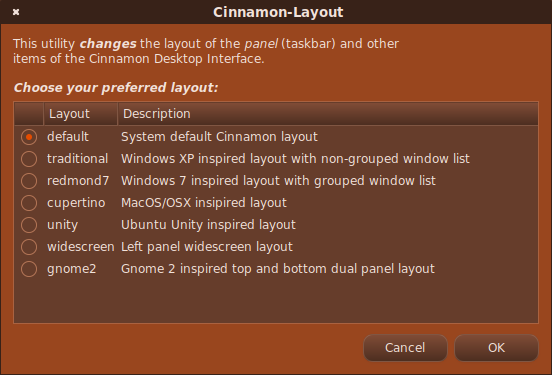
Now, you have the ability to switch between and try out the different desktop layouts available. If you are following along on this adventure, please do not hesitate to report any bugs you find with this new tool on the project’s official GitHub page. More exciting news to come soon!
As always, thanks for your support!
Ubuntu MATE Community — New User of the Month, January 2020
Thanks to the incredible team behind Ubuntu MATE, I received a really awesome and unexpected message this week:

Though I’ve only been using Ubuntu MATE for a couple of weeks now, it definitely feels like home. I’ll be hanging around their official forums, so come check them out and join in on the discussions. You just may be able to help shape the future direction of the distribution!
Just for fun, here is the most recent variation of my Ubuntu MATE setup (make sure to check out the reddit post on it as well for a few laughs):
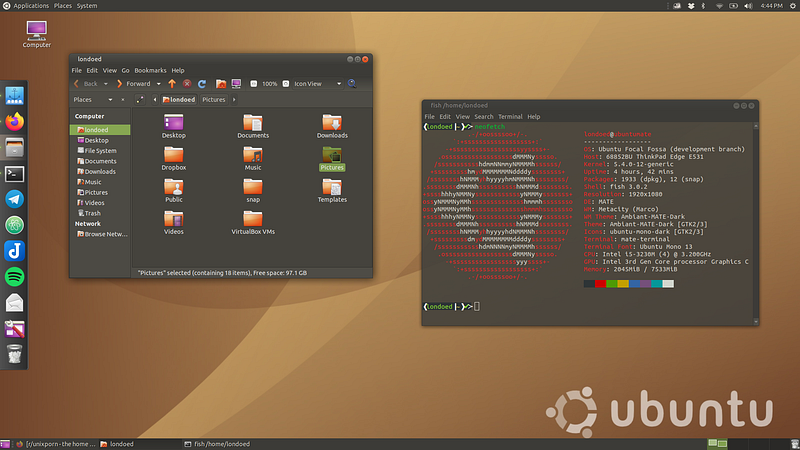
Here is my desktop setup:
OS: Ubuntu MATE Focal Fossa
Shell: fish 3.0.2
DE: MATE (Traditional Layout)
WM: Metacity (Marco)
WM Theme: Ambiant-MATE-Dark
Theme: Ambiant-MATE-Dark
Icons: ubuntu-mono-dark
Wallpaper: Ubuntu 6.06 Simple Human
Linux Community News
Linux Kernel 5.5 is Here!

Earlier this week, Linus Torvalds announced that Linux Kernel 5.5, code-named “Kleptomaniac Octopus”, has been officially released and with it comes many welcome upgrades and support patches.
One of the biggest additions in the updated kernel is support for the latest iteration of the popular microcomputer, the Raspberry Pi 4. This means that any distribution of Linux with the newest kernel patch should work on this device properly without any need for tweaking.
Additionally, a new driver for checking temperature information on an NVMe SSD drive has been added through HWMON insysfs. This should provide the ability to monitor the health of your SSD straight from the command line much easier without the need for opening up any special applications or utilities.
The list of updates is incredibly long, but some of the other major highlights include new features for the ext4 filesystem, faster btrfs copying functionality, increased support for a variety of Intel architectures, AMD Navi GPU overclocking, and KUnit, a unit testing framework specifically made for the Linux kernel itself.
There is a ton of information packed into this latest release and with the excitement surrounding it comes the preparation for an even more highly anticipated kernel update, version 5.6. Life is good in the Linux world!
To view a well-curated and extremely detailed list of the all the added improvements to the kernel in 5.5, check out Michael Larabel’s (of phoronix.com) feature overview here.
Kali Linux 2020.1 Officially Released by Offensive Security

The popularity of Offensive Security’s Kali Linux has found substantial growth over the past few years. This may be due in part to its extensive appearance on USA Network’s Mr. Robot, however, the incredible versatility, tooling, and flexibility available in Kali no doubt play a massive part in it’s continued success (NOTE: If you haven’t seen Mr. Robot, do yourself a favor and check it out. Thank me later!).
There have been quite a few considerable alterations to the pentesting distribution of choice over the past few releases. From switching out the default GNOME 3 environment in favor of the more lightweight XFCE to introducing Undercover Mode, the Kali developers have been hard at work improving the functionality and performance of their hacker masterpiece.
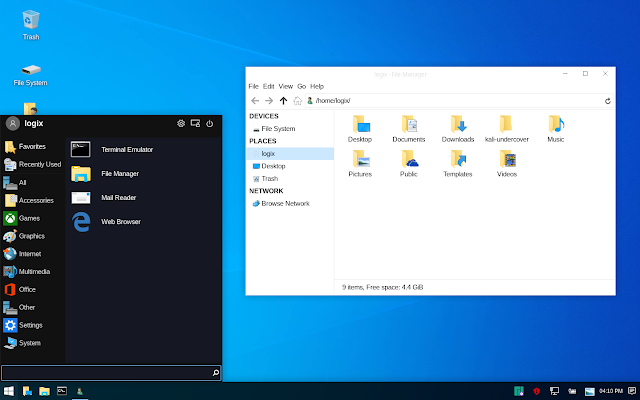
However, the most seminal change to the distribution yet, may have just happened with this first release of the new decade. It appears the team behind Kali have decided to reverse critical functionality that has a vast amount of history within the distribution dating back to it’s early days as BackTrack.
Yes, it is hard to believe, but Kali will no longer feature the root user as the default user. The default login credentials have been changed from root/toor to kali/kali. This move mirrors a more traditional experience, echoing the way that more user-friendly Linux distributions approach login. For newer or inexperienced users, having constant access to the root user account, especially with the powerful tools pre-packaged with the distribution, can be detrimental if you do not have significant knowledge of proper usage.

However, fear not, if you are a master Kali user and you prefer having root privileges at all times, there is a simple solution. In order to return to Kali’s old model, users can run the following commands:
~$ sudo apt install kali-grant-root
~$ dpkg-reconfigure kali-grant-root
In addition to this massive change, Kali has also implemented a single installer image that can run offline and will allow you to decide on the specific pieces of your system including your preferred desktop environment and the tools that you wish to have available upon boot. Do note, this is only for people who are installing Kali on their physical system. To create live media, you must still download the live image. You can find all of Kali’s updated images here.
So naturally, with these drastic alterations, the question will arise: Am I able to use Kali as my daily driver finally? Well, yes, you could always use Kali as your daily driver, but it has never been recommended by the Kali developers in the past and that recommendation continues even with this more user-friendly shift. As for why they don’t encourage it, here is an excerpt from their official announcement post:
“Why do we not recommend it?
Because we are unable to test for that usage pattern and we don’t want the influx of bug reports that would come with it. If you are brave enough to try it, you may switch the branch from “rolling” to “kali-last-snapshot” to try and be more stable”
So, there you have it, tread at your own risk! 🙂
If you would like to check out the official Kali announcement for version 2020.1, you can find it here. Additionally, if you would like to delve deeper into the Kali developer’s decision behind changing the login credentials, you can find their post about it here.
The PinePhone “BraveHeart” Edition Has Been Unleashed
After their resounding success with the recent edition of the PineBook Pro, Pine64 is once again making waves in the Linux hardware space, this time in the mobile arena.
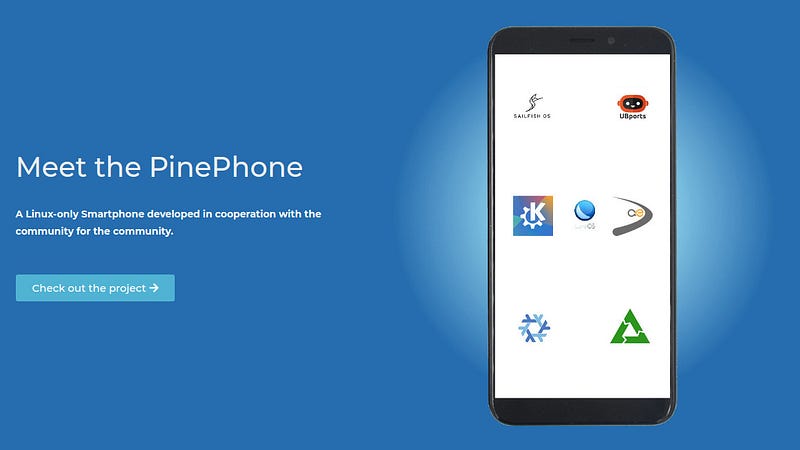
That’s right, Pine64’s PinePhone “BraveHeart” Developer Edition has started arriving to those who pre-ordered their model back in November last year. Pine64 notes up front that this is not a final, nor fully-functional, product by any means, in fact, it was built for experienced Linux developers to test out the phone and help make improvements for future iterations.

The PinePhone allows users to flash different Unix-based mobile operating systems onto the phone including postmarketOS (which comes standard on the device), UBPort’s Ubuntu Touch (based on continued development of Canonical’s Unity8 technology), Plasma Mobile (from the KDE developers), SailfishOS, NixOS, Nemo Mobile, Maemo Leste, LuneOS, and Manjaro ARM. It is technically possible to use any ARM-based Linux operating system due to the fact that the PinePhone uses the mainline kernel, however, the above are specifically designed for the PinePhone’s interface.

At a whopping 150 USD (/sarcasm), the PinePhone places itself in nice position to compete with the two mobile operating giants of our time, Google’s Android and Apple’s iOS, especially for those seeking quality hardware at extremely affordable prices with concerns over personal freedom and security.
It will definitely be interesting to see how the developers feel about this initial offering from Pine64 as more and more phones reach their destinations. For now, here is a video by Pine64 detailing the hardware involved in the “BraveHeart” edition:
Congratulations to Pine64 for the incredible work they’ve done bringing these Linux-based products to the community. I have a feeling there will be many exciting times for Pine64 and the open-source mobile market ahead!
A Major Move for the Qt Platform

On Monday, the team behind the popular Qt development platform announced some hefty changes that have the developer community bustling. From their official statement:
“To support the continuous growth that’s required to keep Qt as a development platform relevant, we need to make changes to our offerings:
- Installation of Qt binaries will require a Qt account
- Long-term-supported (LTS) releases and the offline installer will become available to commercial licensees only
- New Qt offering for start-ups and small businesses for $499/year
These changes will not have any effect on existing commercial licensing or services agreements.”
Starting in February of this year, anyone who wishes to download any Qt binary packages (even open-source developers) will be required to set up a valid Qt account. This new decision seems to be guided by the fact that Qt believes that having your own account will allow you to use their services as effectively as possible while also helping to contribute back to the project itself.
The main goals of this initiative are to have Qt developers file bug reports, interact with their developer forum, take place in code reviews, as well as push users to utilize their new centralized platform, the Qt Marketplace. If you are now required to create a Qt account, you may find the means to do so here.

Additionally, beginning with Qt 5.15, LTS releases and the offline installer will become available to commercial customers only. Qt will continue to provide patch releases to 5.15 until a new point release is available. Once that happens, the non-commercial user will be encouraged to update to the newest release as there will only be minimal support for them regarding patching in the LTS release.
The decision to make this change is to motivate their open-source users to adopt new versions of the platform in order to increase the feedback that Qt receives as well as put an emphasis on companies whose products require a longer product life cycle to consider migrating to their commercial support platform.
Finally, Qt has decided to create a new support offering for start-ups and small businesses that have an annual revenue or funding below $100,000 per year and fewer than five employees. This special edition will allow those who qualify to benefit from tools that a commercial license provides, but at a lower price of $499 per year. However, this license will only provide the full Qt for Device Creation product, without any distribution licenses (which require separate negotiations). Moreover, the new license will only come with installation support as opposed to the full support provided by the commercial license.
If you or your company are interested in this new plan, you can find more information here. The original announcement from the Qt Company can be found here.
There are definitely a wide range of reactions to this announcement, but the Qt Company firmly believes that these changes are necessary for their particular business model and will allow the platform to grow and evolve along with the market. The fallout, if any, from these crucial decisions is yet to be seen.
The Windows 7 Dilemma
With the deprecation of Windows 7 at the start of the new decade, there has been a large void for many home desktop users all over the world that some think Linux has the capacity to fill. Sure, free upgrades to the latest Windows 10 were made available, but many Windows 7 users continue to use hardware that is incompatible with recent versions of Windows 10.

One of the companies in the Linux space that is providing extensive guidance and support to home desktop users seeking alternative solutions is Canonical, the company behind the monumentally popular Ubuntu distribution. Just in the past two weeks, they have written and released two major blog posts to both convince users to make the switch to Linux as well as provide a light to guide them down the path of least resistance.
The first official blog post, Why You Should Upgrade Windows 7 to Ubuntu by Rhys Davis, is a very non-technical, user friendly piece arguing that Ubuntu (or new user-friendly Linux in general) is clearly the best choice for those seeking Windows 7 alternatives.
The second official blog post, How to Upgrade from Windows 7 to Ubuntu — Hardware and Software Considerations by Igor Ljubuncic, details the easiest way to migrate your existing machine to Ubuntu while also taking into consideration the different tools that you will need to port over from Windows 7 or find replacements for in the open-source world.
Furthermore, at CES earlier this year, computer manufacturer megalith, Dell, showcased their new XPS 13 Developer Edition preloaded with Ubuntu front and center at their booth. This was considered a major win for mainstream Linux exposure by the community.
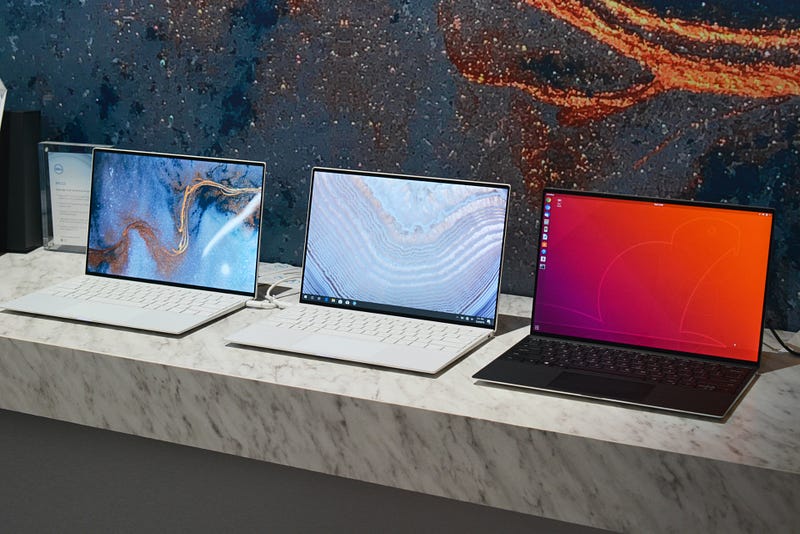
Dell began their partnership with Canonical to ship the latest Ubuntu LTS on their developer-oriented laptop line through a small skunkworks initiative codenamed “Project Sputnik”. Many Linux enthusiasts hope that one day large companies like Dell will offer a wider variety of models that come preloaded with Ubuntu (or any Linux distribution) at various price points that will be easily found at major commercial retailers, such as Best Buy. This move would undoubtedly help to bring Linux to a much more general audience if successful.
Canonical has oft been perceived to focus on their desktop offerings more so than the other Linux enterprise companies (definitely not hating on Red Hat or SuSE, Fedora and openSUSE are among the best desktops in their own right!), so it is no surprise that they are at the forefront of attempting to convert Windows 7 users to their flagship, Ubuntu Desktop.

The impact, improvement, and innovation that Canonical and the supporting Ubuntu community have provided to desktop Linux over the past fifteen years is incalculable and has fervently blazed the trail for Linux distributions of all kinds to become actual competitors in the greater desktop landscape.
Now, we will have to wait and see if their efforts eventually pay off by pulling ordinary desktop users from the grip of the Windows ecosystem to the (hopefully) open arms of the Linux community.
Only time will tell.
Do you think that the Linux community should be pushing Windows 7 users into our ecosystem (or at least opening a door)? If so, how should we be going about it? If not, why is it a bad idea and what would you propose?
Let’s start a discussion! Send me an email at linuxplusplus@protonmail.com with your thoughts on this topic and I may feature it in next week’s issue!
In the Trenches: Ubuntu Budgie

Recently, Jason Evangelho sat down for an in-depth interview with Ubuntu Budgie’s Dustin Krysak on his popular Destination Linux Network (DLN) podcast, Linux For Everyone. This was definitely not your normal interview, that’s for sure!

In this episode, Dustin provides an extremely valuable window into the world of Linux distribution development and I think some of his statements, concerns, and thoughts are incredibly surprising and powerful. If you’ve ever wanted to see what it is like to become a contributor to a distribution, or any open-source project, then this is something you absolutely cannot miss.
If you love an open-source project and have some free time that you would be able to volunteer, please contact the team behind the project. You do not have to be a developer to provide valuable assets to the project because there is so much more to a project than just writing code. Everyone has the capacity to provide some type of service that it will greatly benefit from. If you are willing to help out to keep the software you use available and up to date, the massive people power problem that Dustin refers to in this interview could possibly be mitigated somewhat.
Believe me, developers love it when people take an interest in their project. Most open-source software leaders will be more than happy to receive a message from you asking to work on their project and politely point you to the proper team members who can figure out where you would best fit within the scope. In addition, they will be incredibly grateful for the work you do, no matter how insignificant you may think it is. Every hand involved in an open-source project helps make it more likely to survive and gain greater visibility through success.

You can download Ubuntu Budgie if you’d like to give it a try here. You can also follow the project, request support, or find a way to help on their dedicated Discourse forum here.
Episode 25 of Linux For Everyone is available on all of the major podcasting platforms, but the official website’s episode player is linked below:Episode 25: Helping Hands (with Ubuntu Budgie’s Dustin Krysak)
A frank conversation with Ubuntu Budgie Team Member Dustin Krysak. This interview covers a huge range of topics, from…www.linux4everyone.com
Community Voice: Eric Adams
This is a new section integrated into Linux++ that will serve to provide a structured interview with one member of the GNU/Linux community from time to time.

This week we welcome Eric Adams, a long-time Linux user and open-source enthusiast who has one of the most incredible stories and is truly a kind and wonderful personality entrenched deeply in our community. You may know him through the Destination Linux Network as the co-host of the DLN Xtend podcast as well as a prominent voice on Big Daddy Linux Live! (BDLL). In addition, Eric hosts his own YouTube channel that covers a wide variety of Linux-related topics. I’m happy to present my interview with Eric below:
How would you describe Linux to someone who is unfamiliar, but interested?
“Linux as a desktop operating system is a free and open alternative to the mainstream options that most people are familiar with. It can be installed and run on most computers and provides many interesting advantages over its mainstream counterparts. It is generally very stable and secure, provides a familiar, but customizable experience, easy access to thousands of applications and is mostly unencumbered by restrictive licenses and business practices that limit what you can do with your personal computer.
I believe that most people can and would benefit from using desktop Linux on their computers. There are instances where it is not a good fit, however. Some proprietary software only runs on Windows or macOS. Some hardware is not supported on Linux, or at least to the degree that it is on other OSes. Most computers do not come with Linux installed so users have to install it themselves, which can be a challenge for many. There is a period of adjustment from the way users are accustomed to using their computer that can be difficult.
Fortunately, there are distributions aimed at beginners and some tremendously helpful communities that take it upon themselves to welcome and support new users. They can help ease this transition.”
What got you hooked on the Linux operating system and why do you continue to use it?
“I was initially interested in Linux on servers and spent several years using it exclusively for server-oriented tasks. Desktop Linux at the time was not particularly refined in my view and wasn’t a great option for me. I occasionally used it, but wasn’t immediately convinced. Ubuntu really changed my opinion and I began using it on a regular basis, mostly at home on my personal computer.
What captivated me then and now is the freedom to change things in the way that suits me best. I dictate how the computer works, not the other way around. Distributions give me a starting point and then I am free to do as I please. Once I had this perspective on using a computer it was hard to use anything else.”
What do you primarily use Linux for? (Gaming, Development, Casual Use, Tinkering/Testing, etc.)
“All of the above. I have used Linux exclusively for many years. I previously needed to use Windows professionally, but that’s no longer the case. I assume I am more involved with tinkering and testing than other users, but that is entirely by choice because it’s something I enjoy doing.
It is a bit mind blowing to see how refined most distributions are now and how it isn’t really necessary to make changes to get things working the way it had been in the past. Just about anyone can install a distro and just use as-is.”
What is your absolute favorite aspect about being a part of the Linux community?
“A few things stand out. One, having peers is a great thing. I spent many years not being part of any communities and feeling like I was the only person interested in Linux. Add to that having a career in IT and a general interest in technology with almost nobody around sharing those interests. These aren’t subjects that the majority of people are familiar with or interested in talking about, so it can make you feel isolated and odd. Being able to talk to others and share your enthusiasm is a powerful thing.
I have met some genuinely wonderful people, many of whom I now consider friends. This hasn’t been my typical experience in socializing online. I suppose that’s a very personal experience that others haven’t had, but it surprises and delights me to be a part of this group of people. I have learned so much just by participating in the community and wish I had engaged sooner than I did.”
Do you prefer a distribution (or family of distributions) that you find yourself being drawn to most and why? Do you prefer a particular desktop environment(s) for your workflow and why?
“I am unashamedly a huge fan of Ubuntu and its many flavors and derivatives. It has suited me since I first started using it and continues to provide the best experience for me, personally. I also like Arch and find it to be a very close second, although it is an entirely different experience. Ubuntu is easier and does most of the work for me, while Arch is much more work to get it where I need it to be.
I prefer KDE Plasma and Cinnamon, but I also like GNOME. They all offer something different and, depending on the situation, are the best tool for the job. Plasma is familiar, solid, highly customizable and ever-evolving. It’s the most powerful in terms of capability and customization, sometimes to a fault. It is, however, consistently my fallback. I always have an install of Kubuntu somewhere in case all else fails.
GNOME is beautiful and elegant in many ways. I normally only have to change a few things, add some extensions, tweak a few settings and then it does what I need it to do. Stability has been an issue for me at times and can be frustrating. It has improved quite a bit recently, but there are some fundamental issues that have yet to be solved.
Cinnamon is the intersection of Plasma and GNOME for me. It is familiar and customizable, clean and elegant, stable and usable, and incorporates the best of what I like about Plasma and GNOME. It’s a little surprising to me that it isn’t more popular, although I’m sure thousands of Linux Mint users wouldn’t be.”
What is one FOSS project that you are currently following to watch grow and see the direction it moves in?
“It’s hard to choose just one. There are so many excellent projects that I benefit from every day. One in particular is the Olive video editor. I have been using their alpha release for the past year and I have found it to be nearly perfect for my needs. They are currently working on a major rewrite and I am very much looking forward to seeing what they come up with. There isn’t much that I can do to directly contribute, so I am a patron providing a small monthly financial contribution that hopefully helps them.”
What do you think the short-term and long-term future of Linux holds?
“In the short-term, Desktop Linux will continue to appeal to a small segment of computer users who want or need the power and flexibility it offers. It could and would work well for the vast majority of computer users, but until they can get a computer with it already installed, few of them will ever know about it or use it. I don’t fault the hardware manufactures for not offering these computers because it isn’t as easy as just selling the computer. They need to have an entire organization behind the product and that requires a huge effort on their part, which could only work if there was actually demand for such a product. That said, there are many smaller manufacturers that are filling this need and they could potentially see growth because of this.
Long-term, I think Linux will continue to dominate the server space, IoT, and portable devices, robotics, AI, advanced computing, and the scientific and engineering fields in general. I’m interested to see where Microsoft is headed with things like WSL and how it influences what they offer as a desktop operating system in the future. Maybe the concept of computers will see a shift with better AI and form factors providing real alternatives to the traditional personal computer paradigm.”
How did you find podcasting and become involved with the Destination Linux Network?
“Part of my becoming involved with the greater Linux community lead me to Destination Linux. I had been participating in the Big Daddy Linux live streams and was getting comfortable speaking to others. I was a patron of DL and would attend their recording sessions. I was asked if I wanted to be a guest host, agreed, and ended up enjoying it. When DLN was forming, I was asked if I would like to start a podcast on the network and thought it would be a good chance for me to learn something new. It has been a great experience and I’m very glad I had the opportunity.”
What is your favorite part about hosting your own podcast, DLN Xtend?
“Definitely working with Nathan Wolf (CubicleNate). He’s one of those wonderful people I’ve met and become friends with since becoming involved with the community. The premise of the podcast is to discuss topics covered on the other Destination Linux Network shows, but really it’s a conversation between two people and their interest in Linux and FOSS. I think that’s what makes it interesting and relatable. I make my own YouTube content and write articles on my own, but I don’t feel like it’s as engaging and rewarding as working with others. There’s something special about good conversation that can bring out the best we have to offer.”
Do you have any major goals that you would love to achieve in the near future related to your involvement with the Linux community?
“My main goal is to help people through the content I produce. Often times it is very specific and only of interest to a few people. Sometimes I cover things with wider appeal. In either case, if someone solves a problem or learns a new thing, I feel like I have done some good. I’m not a developer and I have limited financial means, so it’s one of the few ways I have found to contribute something (hopefully) meaningful back to those from whom I have gained so much.”
A special thank you to Eric for being the first interviewee on Linux++! If you would like to follow Eric on Twitter, you can do so here. You can also find him on Telegram here or Mastodon here.
If you would like to learn more about Eric and his journey into the Linux world, check out his wonderful and compelling interview on Episode 11 of Linux Spotlight here.
I can’t wait to delve into the community more and uncover the uniqueness, passion, and thoughts of each individual out there!
Linux Desktop Setup of the Week
This week’s selection was presented by u/gamemasta114 in their post titled, A Little [Cinnamon] Love — Linux Mint 19.3. Here is the accompanying screenshot they posted:

And here are the system details from u/gamemasta114:
OS: Linux Mint 19.3
DE: Cinnamon
Theme: Arc Darkest
Icons: Arc Darkest Suru
Wallpaper: Linux Mint Dark Blue Wallpaper
Thanks, u/gamemasta114, for an incredibly futuristic looking Cinnamon desktop!
If you would like to browse, discover, and comment on some interesting, unique, and just plain awesome Linux desktop customization, check out r/unixporn on Reddit!
See You Next Week!
I hope you enjoyed reading about the on-goings of the Linux community this week. Feel free to start up a lengthy discussion, give me some feedback on what you like about Linux++ and what doesn’t work so well, or just say hello in the comments below.
In addition, you can follow the Linux++ account on Twitter here, join us on Telegram here, or send email to linuxplusplus@protonmail.com if you have any news or feedback that you would like to share with me.
Thanks so much for reading, have a wonderful week, and long live GNU/Linux!

Be the first to comment at forum.tuxdigital.com